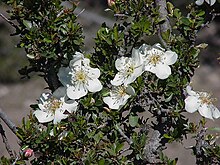Maleae
| Maleae Temporal range:
| |
|---|---|

| |
| Lindleya mespiloides in bloom | |
| Scientific classification | |
| Kingdom: | Plantae |
| Clade: | Tracheophytes |
| Clade: | Angiosperms |
| Clade: | Eudicots |
| Clade: | Rosids |
| Order: | Rosales |
| Family: | Rosaceae |
| Subfamily: | Amygdaloideae |
| Tribe: | Maleae Small 1933 |
| Subtribes | |
| |
| Synonyms | |
The Maleae (incorrectly Pyreae) are the apple tribe in the rose family, Rosaceae. The group includes a number of plants bearing commercially important fruits, such as apples and pears, while others are cultivated as ornamentals. Older taxonomies separated some of this group as tribe Crataegeae,[2][3] as the Cydonia group (a tentative placement),[3] or some genera were placed in family Quillajaceae.[3]
The tribe consists exclusively of shrubs and small trees. Most have pomes, a type of accessory fruit that does not occur in other Rosaceae. All except Vauquelinia (with 15 chromosomes) have a basal haploid chromosome count of 17, instead of 7, 8, or 9 as in the other Rosaceae.[4]
There are approximately 28 genera that contain about 1100 species worldwide, with most species occurring in the temperate Northern Hemisphere.
Current classification
[edit]Core members of the group
[edit]A traditional circumscription of Maleae includes the following genera:[2][3][5][6]
- Amelanchier - serviceberry, juneberry, saskatoon, sugarplum
- Aria - whitebeam
- Aronia - chokeberry
- Chaenomeles - Japanese quince
- Chamaemeles
- Chamaemespilus - false medlar
- Cormus - service tree
- Cydonia - quince
- Dichotomanthes
- Docynia
- Docyniopsis
- Eriobotrya -loquat
- Eriolobus
- Hesperomeles
- Heteromeles - toyon
- Malacomeles - false serviceberry
- Malus - apple, crabapple
- Osteomeles
- Peraphyllum - wild crab apple, squaw apple
- Phippsiomeles[7]
- Photinia
- Pourthiaea[7]
- Pseudocydonia - Chinese quince
- Pyrus - pear
- Rhaphiolepis - hawthorn
- Sorbus (s.s.) - rowan
- Stranvaesia[7]
- Torminalis - chequer tree
- × Amelasorbus
- × Malosorbus
- × Sorbaronia
- × Sorbopyrus
and graft chimeras:
+ Pyrocydonia (Pirocydonia)
Tribe Crataegeae
[edit]A recent taxonomic treatment includes the following genera in Maleae that were earlier separated as tribe Crataegeae (or as intertribe hybrids):[10]
- Cotoneaster - cotoneaster
- Crataegus - hawthorn
- Mespilus - medlar
- Pyracantha - firethorn
intergeneric (including intertribal) hybrids:[8]
- × Crataemespilus
- × Crataegosorbus
- × Sorbocotoneaster
and the graft hybrid:
Former members of family Quillajaceae
[edit]The following genera were previously placed in tribe Quillajeae in Rosaceae, or in family Quillajaceae. Their fruit are dry capsules, not pomes.
The Cydonia group
[edit]The Cydonia group within the Maloid Rosaceae was a tentative grouping of pome-fruited genera with many ovules (rather than just two) per carpel.[3] The genera involved were:
It is not yet clear whether this group is monophyletic within the Maleae. Molecular data indicate a close relationship between Cydonia and Pseudocydonia.[6] Multiple ovules per carpel also occur in Kageneckia, a non-pome-bearing genus.[6] Chloroplast DNA analysis, but not nuclear DNA, shows a tight relationship between Cydonia and Dichotomanthes, a non-pome-bearing genus.[6]
References
[edit]- ^ "Rosales". www.mobot.org. Retrieved 2023-06-16.
- ^ a b G. K. Schulze-Menz 1964. Reihe Rosales. in A. Engler's Syllabus der Pflanzenfamilien mit besonderer Berücksichtigung der Nutzpflanzen nebst einer Übersicht über die Florenreiche und Florengebiete der Erde, Gebrüder Borntraeger, Berlin
- ^ a b c d e Kalkman, C. (2004). "Rosaceae". In K. Kubitzki (ed.). Flowering plants, dicotyledons : Celastrales, Oxalidales, Rosales, Cornales, Ericales. Vol. 6. Berlin: Springer. pp. 343–386.
- ^ Goldblatt, P. (1976). "Cytotaxonomic studies in the tribe Quillajeae (Rosaceae)". Annals of the Missouri Botanical Garden. 63 (1): 200–206. doi:10.2307/2395226. JSTOR 2395226.
- ^ Sterling, C. (1965). "Comparative morphology of the carpel in the Rosaceae. V. Pomoideae: Amelanchier, Aronia, Malacomeles, Malus, Peraphyllum, Pyrus, Sorbus". American Journal of Botany. 52 (4): 418–426. doi:10.2307/2440337. JSTOR 2440337.
- ^ a b c d Campbell, C.S.; Evans, R.C.; Morgan, D.R.; Dickinson, T.A.; Arsenault, M.P. (2007). "Phylogeny of subtribe Pyrinae (formerly the Maloideae, Rosaceae): Limited resolution of a complex evolutionary history". Plant Systematics and Evolution. 266 (1–2): 119–145. doi:10.1007/s00606-007-0545-y.
- ^ a b c Liu, B.B.; Hong, D.Y.; Zhou, S.L.; Xu, C.; Dong, W.P.; Johnson, G.; Wen, J. (2019). "Phylogenomic analyses of the Photinia complex support the recognition of a new genus Phippsiomeles and the resurrection of a redefined Stranvaesia in Maleae (Rosaceae)". Journal of Systematics and Evolution. 57 (6): 678–694. doi:10.1111/jse.12542.
- ^ a b Stace, C. A. 1975. Hybridization and the flora of the British Isles. Academic Press, London.
- ^ "USDA PLANTS".
- ^ Potter, D.; Eriksson, T.; Evans, R.C.; Oh, S.H.; Smedmark, J.E.E.; Morgan, D.R.; Kerr, M.; Robertson, K.R.; Arsenault, M.P.; Dickinson, T.A.; Campbell, C.S. (2007). Phylogeny and classification of Rosaceae. Plant Systematics and Evolution. 266(1–2): 5–43. doi:10.1007/s00606-007-0539-9
Text is available under the CC BY-SA 4.0 license; additional terms may apply.
Images, videos and audio are available under their respective licenses.
